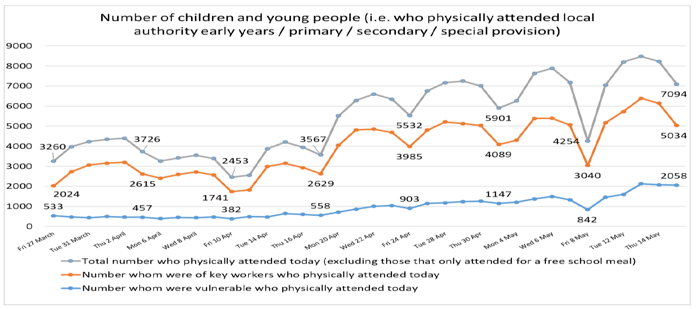Vulnerable children report: 15 May 2020
This is the second report from the Scottish Government with SOLACE and other partners, on the impact of COVID-19 and the lockdown on children and families, and on the ways that services for children have responded. It identifies critical issues for services for children going forward.
What the data tells us
43. Local authorities are having to develop new methods to quantify how regularly children are being contacted, and many don't yet have systems in place, but the data set indicates that three quarters of all children with a support plan are in contact with services and professionals every week.
44. Further, around half of all young people eligible for aftercare were contacted by a professional in the last two weeks (which does not account for the fact that a high percentage within this group choose not to have contact with services).
45. The number of vulnerable children attending education hubs has increased after the Easter break, at more than four times the previous level, albeit these are still relatively low numbers and subject to considerable variation between authorities.

46. It is envisaged that attendance at hubs might increase further, as hub activity is developed, and this is more widely recognised as a positive option for some children and young people.
47. A number of authorities have maintained some dedicated education support for children with disabilities. Some granted aided Residential Schools and Independent Schools are still providing residential provision for children and young people with additional support needs. They have developed adaptable individualised plans to ensure appropriate support is provided whether or not the child or young person is accessing the school through its residential provision.
48. Over 168,000 meals are being provided on a daily basis (with 122,000 children entitled to free school meals) largely through vouchers and direct payments.
49. The high number of children accessing free school meals, indicates a reassuring response to those families who have experienced loss of income during the pandemic. However, there are as yet, few other 'hard' numbers evidencing how agencies have addressed the needs of families that are newly vulnerable due to the financial impacts of social restrictions.
50. It is a major concern, that the evident increased stress and risk factors for children and families, has not been leading to increased number of requests for help from services. There has been a reduction in referrals to social work services during the lockdown period, likely linked to reductions in contact with education and other services. Albeit many families are using websites and helplines to ask for assistance, relatively few of these calls appear to be transitioning into requests for social work support. These trends are evidenced by the graphs in the front data section of this report.
51. Over the last three weeks, it is clear there has been significantly reduced activity, compared with the same period last year:
- 12% reduction in child wellbeing concerns being generated by Police Scotland
- 17% reduction in child protection concerns being generated by Police Scotland
- 20% reduction in cases where Health, Police and Social Work have identified sufficient evidence to consider planning a child protection investigation
- 26% reduction in the number of children identified as needing child protection plans
- 47% reduction in the number of children becoming 'looked after', with a 77% reduction in the number becoming looked after at home.
52. Referrals to the Children's Hearing system have also reduced, and in the period from 23 March – 5 May, again compared to the same period last year:
- Total Referrals reduced from 3043 (2019) to 2296 (2020) – a decrease of 23%
- Non Offence Referrals reduced from 2044 (2019) to 1485 (2020) – a decrease of 27%
- Offence referrals reduced from 661 (2019) 548 (2020) –a decrease of 17%
- Joint Referrals to COPFS/SCRA decreased by 22%
53. Conversely, the number of Child Protection Orders in the last week of April showed a 38% increase of 20 from the 2019 level of 52.
54. The most recent weekly data set suggests that the situation may be changing, and that concerns are returning to the level they were at the same time last year, as shown below. Further weekly reports will confirm if this is being sustained.
| Child Wellbeing Concerns from Police Scotland | Child Protection Concerns from Police Scotland | |
|---|---|---|
| Tuesday 07 May to Monday 13 May 2019 | 2954 | 234 |
| Thursday 07 May to Wednesday 13 May 2020 | 2906 | 226 |
55. It is also important to note that while these figures show a reduction in new demand, it does not take account of the significant increased activity being undertaken with many families already known to social work services.
56. Domestic abuse services continue to indicate an increase in abusive behaviour, and this was a factor in around half of new child protection registrations in the last two weeks – a 14% increase on the proportion at the same time last year. However, agencies report that women and children are struggling to access services, particularly those that usually offer face-to-face provision.
57. The volume and frequency of referrals to most services has reduced dramatically compared to the same reporting period last year, and organisations are concerned that 'new' clients (those who are not already engaged) may not have the opportunity, ability or knowledge about how to access support.
58. There has been engagement regarding this across statutory and Violence against Women & Girls services, and new supplementary guidance for local authorities will be published by COSLA and the Scottish Government, with support of Public Health Scotland, on 15 May.
Contact
Email: bill.alexander@gov.scot
There is a problem
Thanks for your feedback